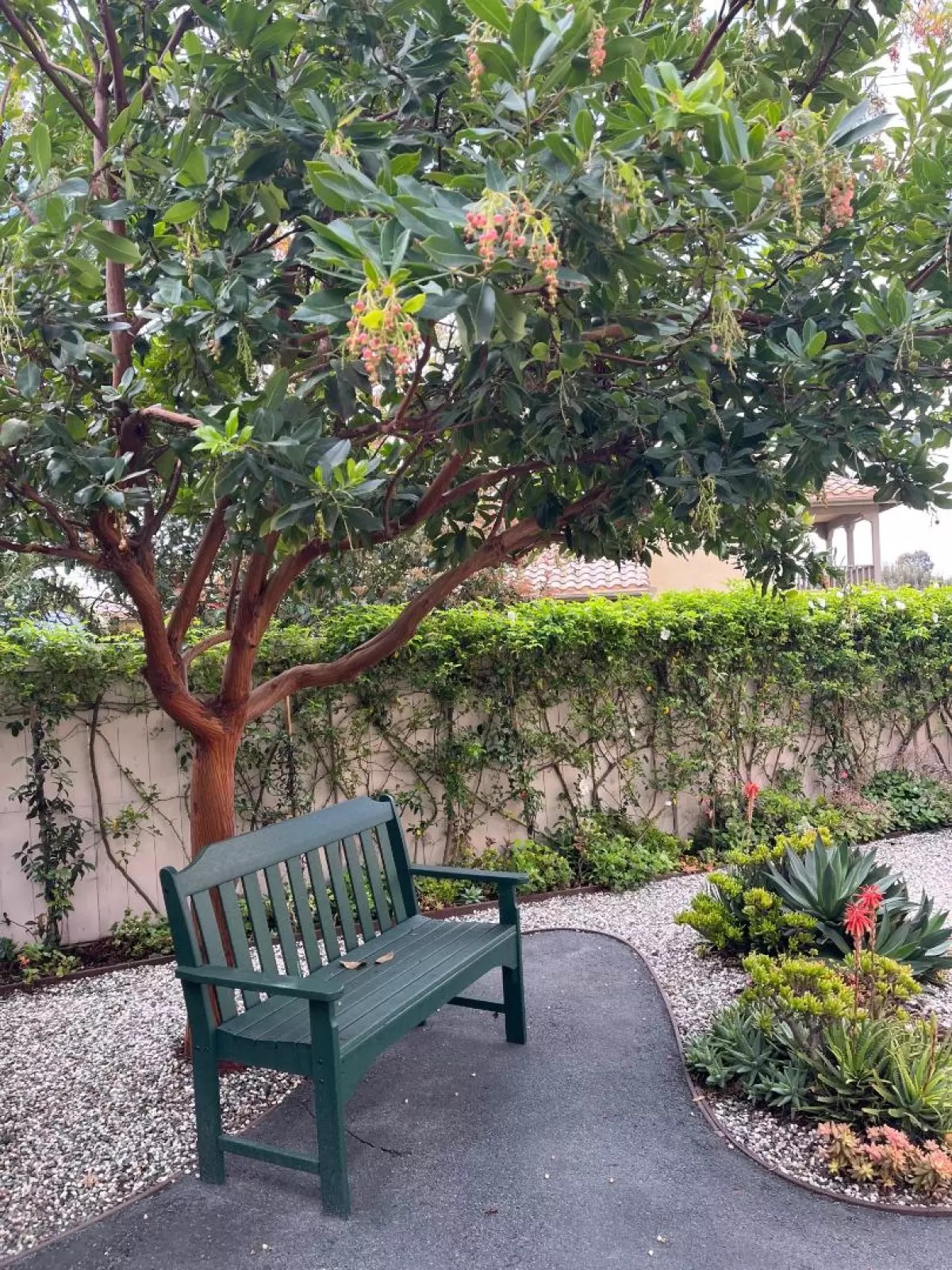The right tree in the right place can last generations

Strawberry Tree - photo credit: Kathy McKee
And we could use more — planting one in the yard might help reverse state’s 30 percent drop in tree density
BY KATHY MCKEE
(This article originally appeared in the APRIL 8, 2023 edition of the San Diego Union-Tribune)
In a corner of our backyard patio, we enjoy a strawberry arbutus tree (Arbutus unedo) with a canopy that provides shade for us and home for several generations of hummingbirds. We planted it 10 years ago and the tree is flourishing. It is the right tree in the right place.
We didn’t do so well with two podocarpus trees (Podocarpus macrophyllus) planted in our front yard a few years before. They also flourished, but we had to remove them when their energetic roots invaded our sewer lines. They were the wrong trees in the wrong place.
With all the benefits trees provide — beauty, shade, wildlife habitat, carbon storage, soil replenishment — and with the investment of time required for them to grow to maturity, we can’t afford to let a tree die before its time or be forced to remove it because it was planted in the wrong place.
California’s tree drought. According to Janet Hartin, UC Cooperative Extension area environmental horticulturist, in addition to the moisture drought we’ve been experiencing over the past three years (helped only slightly by our recent rains), we are experiencing a “tree drought” in California. Since 1988, the density of trees in California has decreased 30 percent. Many of our current street trees are dying prematurely, in part because of a poor selection of trees planted in street medians — the wrong trees. These trees have not been able to withstand increased urban heat and other climate stressors in those locations. Loss of trees in our neighborhoods means loss of all their benefits, and this is something we cannot tolerate. We may not be able to control all the community planting, but we can select the right trees for our own yards.
As National Arbor Day approaches (April 28 this year), consider adding a tree to your personal landscape. In order to give that tree the best chance to live its full life, do some planning. There are many resources available to help you choose the right tree.
Check your climate zone. Select a tree that performs well in your climate zone. Hartin recommends using the Sunset Western Climate Zone maps, which are more precise than USDA zones and more useful for San Diego’s extensive geography: sunsetplantcollection.com/climate-zones/zone/san-diego-region/
Also consider “microclimates” based on more site specific factors like shade, proximity to buildings, space needs below and above ground, soil type and water source. Check with city maps or a plumber to locate underground water lines. San Diego Gas & Electric publishes guidelines for planting trees near power lines and suggestions for appropriate trees: sdge.com/safety/tree-planting-guide
Select a low water tree. Just because we’ve enjoyed a few weeks of much needed rain doesn’t change the pattern of periodic droughts San Diego will continue to experience. The UCANR (University of California Agriculture and Natural Resources) and U.S. Forest Service are currently doing a long-term study of the best trees to survive drought. The study is measuring the performance of select landscape tree species based on heat and drought resistance, carbon sequestration, soil tolerance, pest resistance, shade and biodiversity.
So far, some examples of strong performers that Hartin suggests would be appropriate for San Diego landscape trees include: ‘Red Push’ Pistache (Pistacia × ‘Red Push’) Sunset zones 5-24; Desert Willow Bubba (Chilopsis linearis) Sunset zones 3, 7-14, 18–23; and Palo Blanco (Acacia willardiana) Sunset zones 12-24.
For additional trees, Hartin recommends the following useful websites with searchable plant-selection engines to help you choose a tree by different criteria (size, water needs, flower color, pest susceptibility). Enter your criteria and photos of trees answering that criteria will pop up. Click on the photo to get additional information.
- Cal Poly, Pomona: selectree.calpoly.edu
- California Native Plant Society: cnps.org/cnps/grownative/lists.php
- WUCOLS IV (Water Use Classification of Landscape Species): ucanr.edu/sites/WUCOLS
- Arbor Day Foundation Tree Wizard: arborday.org/shopping/trees/treewizard/GetZip.cfm
Another option. If you don’t have room in your yard for a tree and would still like to foster an increase in our tree canopy, consider other options such as contributing to tree-planting groups. The Village Garden Club of La Jolla sponsors a Commemorative Tree Planting Program: vgclj.com/club-projects. This project receives donations to plant trees in community spaces throughout San Diego in honor of and to commemorate loved ones. The Tree Program is committed to planting the right trees in the right places.
Leave a Legacy. Hartin sums it up eloquently by saying, “If you have adequate space, why not leave a legacy to your children’s children by planting a tree? When the right species is planted in the right location with the right care, landscape trees can be enjoyed for 100 years or more.” Why not, indeed!
McKee has been a Master Gardener since 2016 and currently serves on the board of directors for the Master Gardener Association of San Diego County. She is also co-chair of the Commemorative Tree Project for the Village Garden Club of La Jolla.

